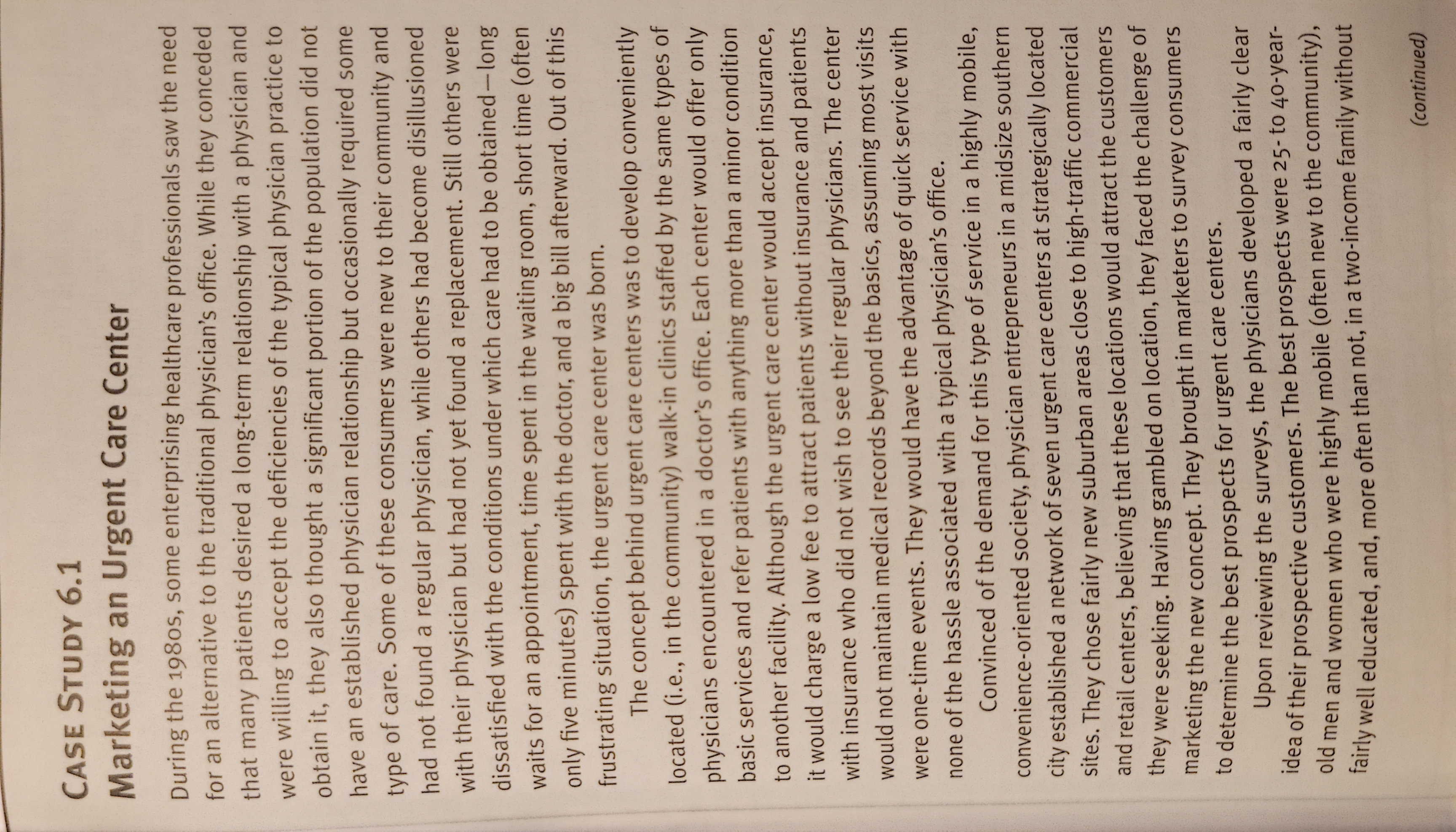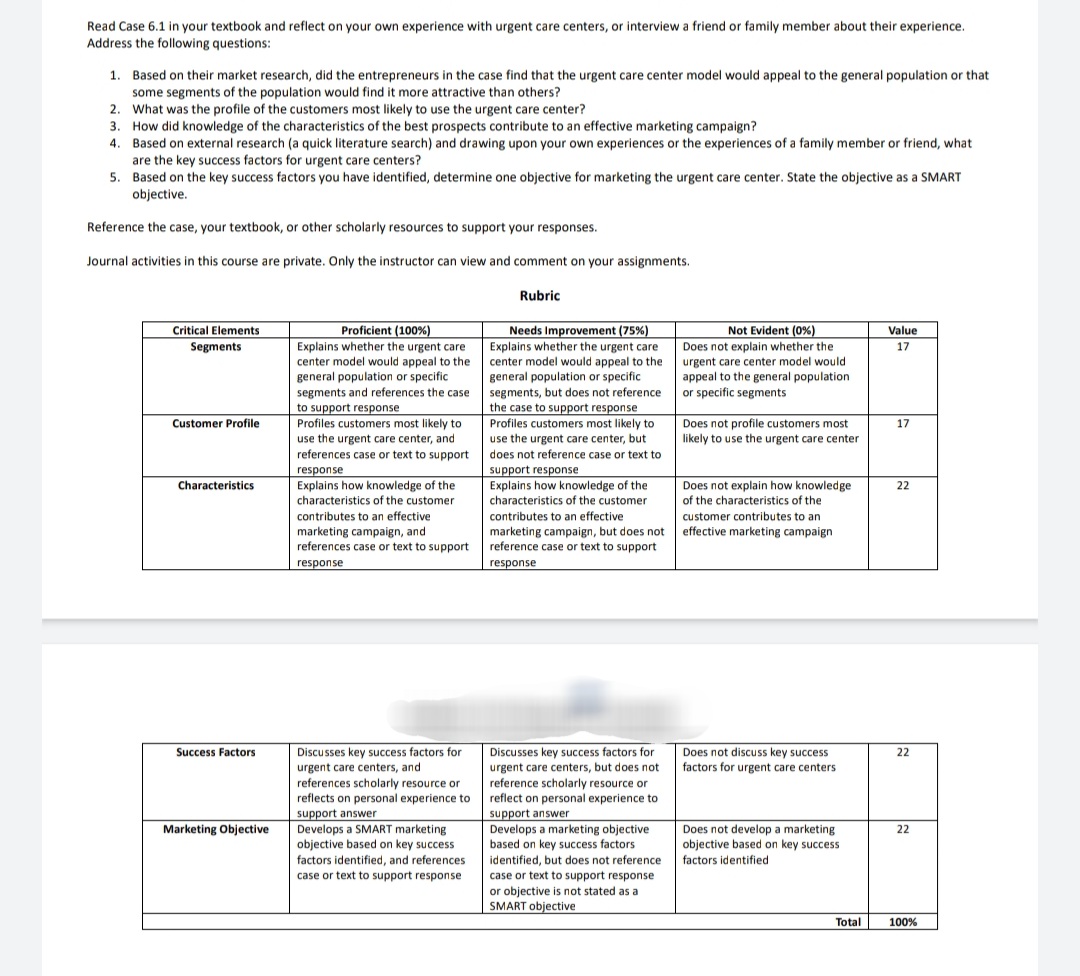Read Case 6.1 in your textbook and reflect on your own experience with urgent care centers, or interview a friend or family member about their experience. Address the following questions:
- Based on their market research, did the entrepreneurs in the case find that the urgent care center model would appeal to the general population or that some segments of the population would find it more attractive than others?
- What was the profile of the customers most likely to use the urgent care center?
- How did knowledge of the characteristics of the best prospects contribute to an effective marketing campaign?
- Based on external research (a quick literature search) and drawing upon your own experiences or the experiences of a family member or friend, what
- are the key success factors for urgent care centers?
- Based on the key success factors you have identified, determine one objective for marketing the urgent care center. State the objective as a SMART objective.
Reference the case, your textbook, or other scholarly resources to support your responses.
?
CASE STUDY 6.1 Marketing an Urgent Care Center During the 1980s, some enterprising healthcare professionals saw the need for an alternative to the traditional physician's office. While they conceded that many patients desired a long-term relationship with a physician and were willing to accept the deficiencies of the typical physician practice to obtain it, they also thought a significant portion of the population did not have an established physician relationship but occasionally required some type of care. Some of these consumers were new to their community and had not found a regular physician, while others had become disillusioned with their physician but had not yet found a replacement. Still others were dissatisfied with the conditions under which care had to be obtained -long waits for an appointment, time spent in the waiting room, short time (often only five minutes) spent with the doctor, and a big bill afterward. Out of this frustrating situation, the urgent care center was born. The concept behind urgent care centers was to develop conveniently located (i.e., in the community) walk-in clinics staffed by the same types of physicians encountered in a doctor's office. Each center would offer only basic services and refer patients with anything more than a minor condition to another facility. Although the urgent care center would accept insurance, it would charge a low fee to attract patients without insurance and patients with insurance who did not wish to see their regular physicians. The center would not maintain medical records beyond the basics, assuming most visits were one-time events. They would have the advantage of quick service with none of the hassle associated with a typical physician's office. Convinced of the demand for this type of service in a highly mobile, convenience-oriented society, physician entrepreneurs in a midsize southern city established a network of seven urgent care centers at strategically located sites. They chose fairly new suburban areas close to high-traffic commercial and retail centers, believing that these locations would attract the customers they were seeking. Having gambled on location, they faced the challenge of marketing the new concept. They brought in marketers to survey consumers to determine the best prospects for urgent care centers. Upon reviewing the surveys, the physicians developed a fairly clear idea of their prospective customers. The best prospects were 25- to 40-year- old men and women who were highly mobile (often new to the community), fairly well educated, and, more often than not, in a two-income family without (continued)children. Whites appeared to be more open to the idea than nonwhites. Those in the middle- to upper-middle-class income categories were great prospects; the more affluent were not attracted, and less affluent populations were intimidated by this practice model and concerned about having to pay cash up front. In terms of lifestyle, the survey showed that those who were pro- gressive, innovative, highly mobile, and more focused on the present than the future were more likely to use the service. This information confirmed the developers' intuition about locating the centers in newly emerging affluent suburbs, and they set out to market this service to the target population. Taking advantage of a variety of data sources, the developers targeted households that displayed the desired characteris- tics within a five-mile radius of each site. Of the seven urgent care centers established, five were successful and two significantly underperformed. The only discernable differences between the successful and unsuccessful ones were the lower visibility and lower drive-by traffic characterizing the latter. The developers' ability to target the most likely prospects helped them launch a successful promotional campaign that quickly resulted in a high volume of business. Without knowledge of the most likely prospects, the marketers' efforts would have been ineffective and the growth of the urgent care center clientele would have been much slower.Read Case 6.1 in your textbook and reflect on your own experience with urgent care centers, or interview a friend or family member about their experience. Address the following questions: Based on their market research, did the entrepreneurs in the case find that the urgent care center model would appeal to the general population or that some segments of the population would find it more attractive than others? 2. What was the profile of the customers most likely to use the urgent care center? 3. How did knowledge of the characteristics of the best prospects contribute to an effective marketing campaign? 4. Based on external research (a quick literature search) and drawing upon your own experiences or the experiences of a family member or friend, what are the key success factors for urgent care centers? 5. Based on the key success factors you have identified, determine one objective for marketing the urgent care center. State the objective as a SMART objective. Reference the case, your textbook, or other scholarly resources to support your responses. Journal activities in this course are private. Only the instructor can view and comment on your assignments. Rubric Critical Elements Proficient (100%) Needs Improvement (75%) Not Evident (0%) Value Segment Explains whether the urgent care Explains whether the urgent care Does not explain whether the 17 center model would appeal to the center model would appeal to the urgent care center model would general population or specific general population or specific appeal to the general population segments and references the case segments, but does not reference or specific segments to support response the case to support response Customer Profile Profiles customers most likely to Profiles customers most likely to Does not profile customers most 17 use the urgent care center, and use the urgent care center, but likely to use the urgent care center references case or text to support does not reference case or text to response support response Characteristics Explains how knowledge of the Explains how knowledge of the Does not explain how knowledge 22 characteristics of the customer characteristics of the customer of the characteristics of the contributes to an effective contributes to an effective customer contributes to ar marketing campaign, and marketing campaign, but does not effective marketing campaign references case or text to support reference case or text to support response response Success Factors Discusses key success factors for Discusses key success factors for Does not discuss key success 22 urgent care centers, and urgent care centers, but does not factors for urgent care centers references scholarly resource or reference scholarly resource or reflects on personal experience to reflect on personal experience to support answer support answer Marketing Objective Develops a SMART marketing Develops a marketing objective Does not develop a marketing 22 objective based on key success based on key success factors objective based on key success factors identified, and references identified, but does not reference factors identified case or text to support response case or text to support response or objective is not stated as a SMART objective Total 100%









